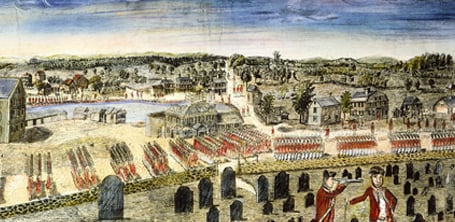- Teacher Resources
- Books & Authors
- Student Activities


Before America was an independent country, the land was divided into 13 colonies all ruled by the king of England. However, life in the colonies differed in many ways from life in England. In fact, English visitors who went to the colonies found it difficult to understand the new way of life that the colonists were leading. The independent spirit and the attitude of the colonists toward the British government were also puzzling to these British travelers.
The people who had journeyed to America from Europe had gone in search of the opportunity to lead a better life and earn a better living. Many had gone to escape the political and religious persecution that existed throughout Europe at that time. America was a land of opportunity.
In time, the colonists learned how to live in the wilderness - through trial and error and the help of some of the more friendly Native American tribes. By the 1700s, small cities and towns were well established. The colonists slowly developed their own customs and lifestyles. Eventually they began to feel that this new land was now their true home.
The British government began to feel that the colonists should pay more of the costs of governing the colonies, including the establishment of an army. They introduced new taxes to raise money from the colonists. In addition, to reduce the possibility of conflicts with the French on the American western frontier, the British issued the Proclamation of 1763. This closed the lands west of the Allegheny Mountains to further settlement or colonization.
These measures angered the colonists. Some people organized against the British. Flames of revolt were rising in Boston, but the British ignored the obvious military preparations of the Americans. The first shots of the Revolution were fired on April 19, 1775, when British troops, searching for hidden arms, clashed with Americans at Lexington, Massachusetts. Eight Americans were killed. As the news spread through the colonies, preparations were made for war.
Although many were prepared to fight, not all colonists were ready for a complete break with Britain. The question of such a split was heatedly debated at the Second Continental Congress before independence was finally proclaimed on July 4, 1776, with the signing of the Declaration of Independence. The Declaration, written by Thomas Jefferson, gave a new dignity to the American cause. The Patriots were now fighting for their freedom as a nation - the United States of America. Even so, thousands of colonists, known as Loyalists, or Tories, kept their allegiance to Britain. After the revolution, many Loyalists fled to Canada or England.
Selecting a commander in chief for the new army called for much consideration. At last Congress chose a 43-year-old Virginian, a man of wealth and position, a colonel in the Virginia militia who had fought in the French and Indian War. His name was George Washington.
The troops he inherited were disorganized and disorderly rather than a disciplined military group. But after Washington came, they began to become an army.
The war continued for five more years. There were many defeats, and at times the American cause seemed hopeless. But the steadfastness shown by George Washington as the commander of the Continental Army kept American hopes alive until victory was gained in 1781. Britain formally accepted American independence in the Treaty of Paris in 1783.
The end of the Revolution brought independence to the 13 colonies, which combined to form the United States of America. The success of the war brought about the first break in the European colonial system and set in motion a chain of revolutions that has continued to this day. The establishment of republican government was finally secured in the United States in 1789 with the adoption of the Constitution.
Abigail Jane Stewart and William Thomas Emerson were both swept up in the spirit of revolution. Read their wartime diaries to learn how young people lived as America struggled for freedom.
